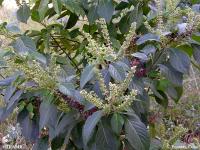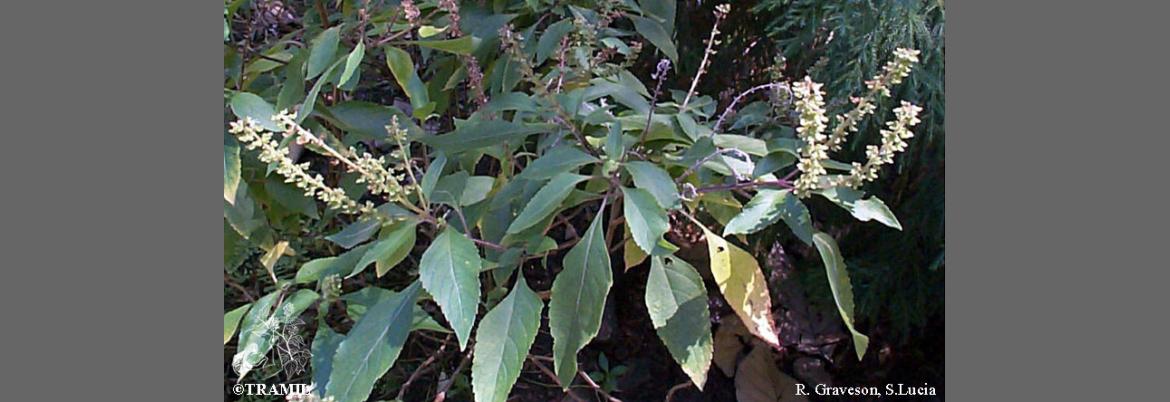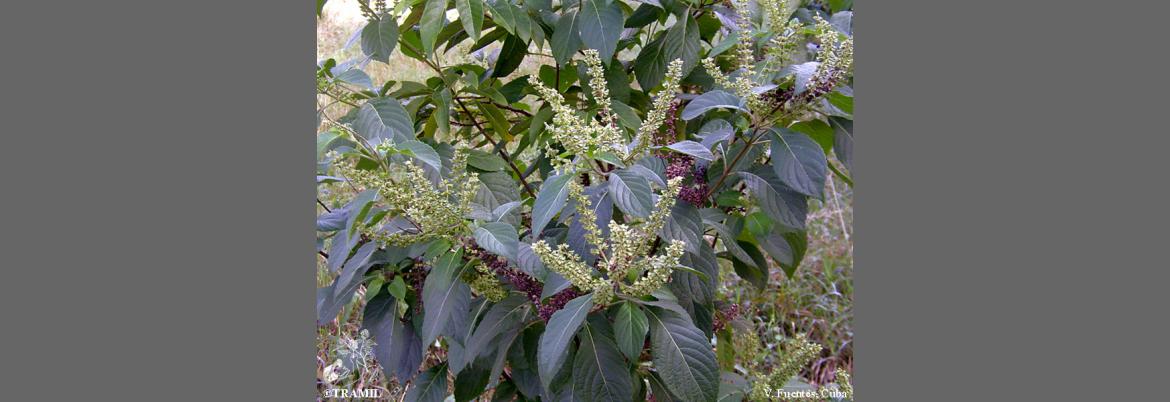1 WENIGER B, 1987-88
Encuesta TRAMIL. enda-caribe, Santo Domingo, Rep. Dominicana.
2 WENIGER B, ROUZIER M, 1986
Enquête TRAMIL. Service Oecuménique d'Entraide SOE, Port au Prince, Haïti.
3 JEAN-PIERRE L, 1988
TRAMIL survey. St. Lucia national herbarium, Castries, St Lucia.
4 GIRÓN L, 1988
Encuesta TRAMIL (Costa atlántica). Centro Mesoamericano de Tecnología CEMAT, Guatemala, Guatemala.
5 WHO, 1991
Guidelines for the assessment of herbal medicines. WHO/TRM/91.4. Programme on Traditional Medicines, WHO, Geneva, Switzerland.
6 WENIGER B, SAVARY H, DAGUIHL R, 1984
Tri phytochimique de plantes de la liste TRAMIL. Laboratoire de chimie des substances naturelles, Faculté de Médecine et de Pharmacie, Université d'Etat d'Haïti, Port au Prince, Haïti.
7 ZAMUREENKO VA, TOKAREVA VY, KLYUEV NA, KARPOVA TI, GRANDBERG TI, 1981
Identification of sesquiterpene hydrocarbons of essential oil from Ocimum gratissimum L. Izv Timiryazevsk S-Kh Akad 1981(4):153-155.
8 NTEZURUBANZA L, SCHEFFER JJC, BAERHEIM-SVENDSEN A, 1987
Composition of the essential oil of Ocimum gratissimum grown in Rwanda. Planta Med 53(5):421-423.
9 ARCTANDER S, 1960
Perfume and flavor materials of natural origin. Elizabeth, USA: Stephen Arctander.
10 HEGNAUER R, 1973
Chemotaxonomy der Pflanzen. Basel, Schweiz: Birkhauser Verlag. 6:882.
11 MAIA JGS, RAMOS LS, LUZ AIR, DA SILVA ML, ZOGHBI MG, 1988
Uncommon Brazilian essential oils of the Labiatae and Compositae. In: Flavors and fragrance: a world perspective, Proceedings of the 10th International Congress of Essential Oils. Lawrence BM, Mookherjee BD, Willis BJ, Eds. New York, USA: Elsevier Sci Publ. p177-188.
12 JANSSEN AM, SCHEFFER JJC, NTEZURUBANZA L, SVENDSEN AB, 1989
Antimicrobial activities of someOcimum species grown in Rwanda. J Ethnopharmacol 26(1):57-63.
13 NIGAM M, KHOSLA MK, BRADU BL, TANDON N, 1988
Hydration of terpene fraction of "Clocimum" oil and isolation of pure myrcene. Parfume Kosmet 69(5):285-286.
14 AWUAH RT, 1989
Fungitoxic effects of extracts from some West African plants. Ann Appl Biol 115(3):451-453.
15 OFFIAH VN, CHIKWENDU UA, 1999
Antidiarrhoeal effects of Ocimum gratissimum leaf extract in experimental animals. J. Ethnopharmacol 68(1-3):327-330.
16 AZIBA PI, BASS D, ELEGBE Y, 1999
Pharmacological investigation of Ocimum gratissimum in rodents. Phytother Res 13(5):427-429.
17 NJOKU CJ, ASUZU IU, 1998
The anthelmintic effects of the leaf extract of Ocimum gratissimum (L.). Phytomedicine 5(6):485-488.
18 ADESINA SK, 1982
Studies on some plants used as anticonvulsants in Amerindian and African traditional medicine. Fitoterapia 53:147-162.
19 EL KELTAWI N, MEGALLA S, ROSS S, 1980
Antimicrobial activity of some Egyptian aromatic plants. Herbal Pol 26(4):245-250.
20 MADEIRA SVF, MATOS FJ, LEAL-CARDOSO JH, CRIDDLE DN, 2002
Relaxant effects of the essential oil of Ocimum gratissimum on isolated ileum of the guinea pig. J Ethnopharmacol 81(1):1-4.
21 BUDAVARI S (Ed.), 2001
The Merck index: an encyclopedia of chemical, drugs, and biologicals. 30th ed. White House Station, New Jersey, USA: Merck & Co., Inc. p1676.
22 ONAJOBI FD, 1986
Smooth muscle contracting lipid-soluble principles in chromatographic actions of Ocimum gratissimum. J Ethnopharmacol 18(1):3-11.
23 LOGARTO PARRA A, TILLAN CAPO J, VEGA MONTALVO R, GONZALEZ YC, 1999
Toxicidad aguda oral de extractos hidroalcohólicos de plantas medicinales. Rev Cubana Planta Med 4(1):26-28.
24 DHAWAN BN, PATNAIK GK, RASTOGI RP, SINGH KK, TANDON JS, 1977
Screening of Indian plants for biological activity. VI. Indian J Exp Biol 15(3):208-219.
25 LOGARTO PARRA A, SILVA YHEBRA R, GUERRA SARDINAS I, IGLESIAS BUELA L, 2001
Comparative study of the assay of Artemia salina L. and the estimate of the medium lethal dose (LD50 value) in mice, to determine oral acute toxicity of plant extracts. Phytomedicine 8(5):395-400.
26 GUERRA MJ, LÓPEZ M, BOUCOURT E, FUENTES V, MORÓN F, 2002
Toxicidad aguda (DL50) de decocción de hojas frescas de Ocimum gratissimum L.Informe TRAMIL. Laboratorio Central de Farmacología. Facultad de Medicina Dr. Salvador Allende. Ciudad de La Habana, Cuba.
27 GUERRA MJ, LÓPEZ M, BOUCOURT E, FUENTES V, MORÓN F, 2002
Clases toxicas agudas de decocción (30%) de hojas frescas de Ocimum gratissimum L.Informe TRAMIL. Laboratorio Central de Farmacología. Facultad de Medicina Dr. Salvador Allende. Ciudad de La Habana, Cuba.
28 GUERRA MJ, LÓPEZ M, BOUCOURT E, FUENTES V, 2002
Toxicidad aguda (DL50) de extracto fluido 30% de hojas secas de Ocimum gratissimum L.Informe TRAMIL. Laboratorio Central de Farmacología. Facultad de Medicina Dr. Salvador Allende. Ciudad de La Habana, Cuba.
29 GUERRA MJ, LÓPEZ M, BOUCOURT E, FUENTES V, 2002
Genotoxicidad in vivo: ensayo de micronúcleos en médula ósea de extracto fluido 30% de hojas secas de Ocimum gratisimum L.Informe TRAMIL. Laboratorio Central de Farmacología. Facultad de Medicina Dr. Salvador Allende, Ciudad de La Habana, Cuba.


















